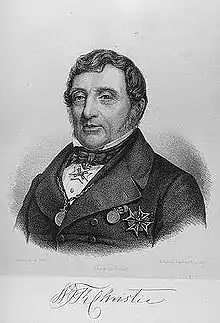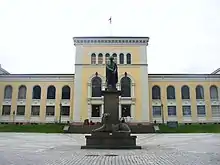Wilhelm Frimann Koren Christie
Wilhelm Frimann Koren Christie (7 December 1778 – 10 October 1849) was a Norwegian attorney. He was a member of the National Assembly at Eidsvoll in 1814 and served as the Norwegian Constituent Assembly secretary.[1]

Background
Born in Kristiansund, Møre og Romsdal, Wilhelm F. K. Christie spent several childhood years in Bergen. He was the son of postmaster Johan Koren Christie (1745–1823) and Anne Thue Brodtkorb (1753–1834). His family can be traced back to Andrew Davidson Christie (ca. 1620-1694), born in Montrose, Scotland, who became a citizen of Bergen in 1654. At 10 years old, he was sent to attend Bergen Cathedral School. At 16 years old, he was a student at the University of Copenhagen. In 1799 he became candidat juridicum.[2]
Career

Wilhelm F. K. Christie was executive officer (kansellisekretær) and head of a government office in Copenhagen. In 1809, at 30 years old, he became a judge (sorenskriver) in Søndre Bergenhus county. From 1815 to 1825 he was County Governor of Søndre Bergenhus amt and County Governor of Bergenhus stiftamt.
In 1814, he was a representative for Bergen at the Norwegian Constituent Assembly. He was chosen as the secretary during the whole period. Hence he did not play a very important role in the debates. Then he participated in sending a message to Great Britain from Christian Frederik in order to win support for Norway's independence. However, this message never was answered. In October he became the president of the parliament and made an important contribution to the process of discussion the union with Sweden. He stayed a representative in the Parliament of Norway (Stortinget) until 1825.[3]
Later years
From 1828 until his death he was a customs inspector in Bergen. He was also a member of Bergen city council from 1837 to 1841, and participated in the founding of Bergen Savings Banks, where he was chairman for several years.[4][5]
Legacy
Christie's private archive in the National Archives contains six packages of correspondence and notes. His statue now stands in front of the Bergen Museum, which he founded in 1825 and worked for more than 20 years. A statue of him by Norwegian sculptor Kristian Blystad was erected during 1989 in front of the Stortinget on the occasion of the Constitution's 175-year anniversary.[6]
References
- "Wilhelm Frimann Koren Christie". Eidsvoll 1814. Retrieved May 1, 2017.
- Wilhelm Frimann Koren Christie (Store norske leksikon)
- Wilhelm Frimann Koren Christie (Stortinget)
- Tidlegare fylkesmenn (Fylkesmannen i Hordaland)
- Wilhelm Frimann Koren Christie, utdypning (Store norske leksikon)
- Kristian Blystad (Store norske leksikon)
| Wikimedia Commons has media related to Wilhelm Frimann Koren Christie. |
| Political offices | ||
|---|---|---|
| Preceded by G. Sverdrup, C. Falsen, C. Diriks, J. Fabricius, D. Hegermann, P. Anker |
President of the Storting 1814-1818 Served alongside: V. Sibbern, C. Diriks, G. Sverdrup |
Succeeded by I. Knudssøn, C. Tank, C. Falsen, A. Arntzen, V. Sibbern |
| Government offices | ||
| Preceded by Johan Randulf Bull |
County Governor of Søndre Bergenhus amt 1815–1825 |
Succeeded by Christian Magnus Falsen |
| Preceded by Johan Randulf Bull |
County Governor of Bergenhus stiftamt 1815–1825 |
Succeeded by Christian Magnus Falsen |